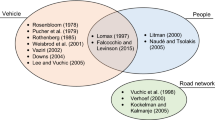Abstract
In optimizing traffic signal timing schemes, various researchers provided their own suggested model to optimize timing plans at isolated urban intersections. Those model formulations were reputed and qualified for their case studies and could apply in different particular circumstances; however, most of the mentioned studies underestimated improving the current traffic control system by advancing traffic efficiency, enhancing traffic safety, and protecting the urban environment simultaneously. Moreover, several stochastic solutions demonstrated taking advantage of searching global optimization results and overcoming the deterministic methods in multi-objective traffic optimization in various pieces of research. In addition, the environmental factor in optimizing traffic lights is also eliminated because current studies mainly focus on traffic efficiency and traffic safety. To limit the shortcomings of the above studies, this study aims to provide an adequate and flexible model formulation to handle the optimal traffic signal timing issue at an isolated signalized intersection in urban areas considering the vehicle exhaust emissions and the other effective objective functions simultaneously by applying the enhanced stochastic solutions. The provided model formulations followed some steps. First, a fitness function based on the simultaneous optimization condition of traffic efficiency functions, traffic safety functions, and protected environment functions was established. Then, the constrained function according to the reliable theoretical basis was generated to improve the search capacity of the suggested model formulation. Next to several enhanced stochastic methods are used to analyze the fitness function constrained genetic algorithm (GA) and constrained particle swarm optimization (PSO). Henceforward, some effective comparisons were made among stochastic solutions, between existing timing plans and suggested timing plans, and between a traditional well-known method and the suggested model. Finally, several robust tools in traffic simulation models were utilized to validate the usefulness of hypothesis model formulation. The empirical outcomes demonstrated that the providing hypothesis model formulation applying stochastic optimization methods in traffic signal optimization was suitable to cope with the traffic signal timing optimization schemes. Besides, the provided comprehensive model could support traffic engineers decrease time calculation by applying suitable operators of GA and PSO.






Similar content being viewed by others
References
Perveen S et al (2017) Evaluating transport externalities of urban growth: a critical review of scenario-based planning methods. Int J Environ Sci Technol 14(3):663–678
Ho TLH, Dinh TH (2021) Evaluating the effectiveness of eco-driving courses based on car-GPS tracking data in the itinerary tracking device to reduce fuel consumption of vehicles in urban areas. In: E3S web of conferences. EDP Sciences
Balta M, Özcelik I (2018) Traffic signaling optimization for intelligent and green transportation in smart cities. In: 2018 3rd International conference on computer science and engineering (UBMK)
Liu Q, Xu J (2012) Traffic signal timing optimization for isolated intersections based on differential evolution bacteria foraging algorithm. Procedia Soc Behav Sci 43:210–215
Hai DT, Manh DV, Nhat NM (2021) Genetic algorithm application for optimizing traffic signal timing reflecting vehicle emission intensity. Transp Prob 17:16
Li Y et al (2011) Mechanism analysis and implementation framework for traffic signal control of over-saturated intersection group. J Transp Syst Eng Inf Technol 11(4):28–34
Chen X-F, Shi Z-k (2002) Real-coded genetic algorithm for signal timing optimization of a single intersection. In: Proceedings. International conference on machine learning and cybernetics. IEEE
Singh L, Tripathi S, Arora H (2009) Time optimization for traffic signal control using genetic algorithm. Int J Recent Trends Eng 2(2):4
Cheng, D., et al. (2003) Modification of Webster’s minimum delay cycle length equation based on HCM 2000. In: Paper submitted to the transportation research board for presentation and publication at the 2003 annual meeting in Washington, DC
Verma A et al (2018) Traffic signal timing optimization for heterogeneous traffic conditions using modified Webster’s delay model. Transp Dev Econ 4(2):1–13
Gao Y-F et al (2012) Multi-objective optimization and simulation for urban road intersection group traffic signal control. Zhongguo Gonglu Xuebao China J Highw Transp 25(6):129–135
Brian Park B, Messer CJ, Urbanik T (2000) Enhanced genetic algorithm for signal-timing optimization of oversaturated intersections. Transp Res Rec 1727(1):32–41
Sun D, Benekohal RF, Waller ST (2003) Multiobjective traffic signal timing optimization using non-dominated sorting genetic algorithm. In: IEEE IV2003 intelligent vehicles symposium. Proceedings (Cat. No.03TH8683)
Li Y et al (2013) Multi-objective optimization of traffic signal timing for oversaturated intersection. Math Probl Eng 2013:1–9
Zhou P, et al (2017) Data analysis with multi-objective optimization algorithm: a study in smart traffic signal system. In: 2017 IEEE 15th international conference on software engineering research, management and applications (SERA)
Zhao H, Han G, Niu X (2020) The signal control optimization of road intersections with slow traffic based on improved PSO. Mobile Netw Appl 25(2):623–631
Zakariya AY, Rabia SI (2016) Estimating the minimum delay optimal cycle length based on a time-dependent delay formula. Alex Eng J 55(3):2509–2514
Yu D et al (2016) Signal timing optimization based on fuzzy compromise programming for isolated signalized intersection. Math Probl Eng 2016:1–12
Shen Y (2018) An optimization model of signal timing plan and traffic emission at intersection based on Synchro. IOP Conf Ser Earth Environ Sci 189(6):062002
Qian R et al (2013) A traffic emission-saving signal timing model for urban isolated intersections. Procedia Soc Behav Sci 96:2404–2413
Jia H et al (2019) Multi-objective optimization of urban road intersection signal timing based on particle swarm optimization algorithm. Adv Mech Eng 11(4):168781401984249
Qiao F, et al (2018) NSQGA-based optimization of traffic signal in isolated intersection with multiple objectives. In: Innovative techniques and applications of modelling, identification and control. Springe, pp 291–305
Li X et al (2004) Signal timing of intersections using integrated optimization of traffic quality, emissions and fuel consumption: a note. Transp Res Part D Transp Environ 9(5):401–407
Manh DV et al (2020) Multiple objective genetic algorithms for solving traffic signal optimization issue at a complex intersection: a case study in Taichung City,Taiwan. Open Civ Eng J 14(1):126–140
Roess RP, William ESP, McShane R (2004) Traffic engineering, 3rd edn. Pearson Education International, New York
Mannering FL, Washburn SS (2020) Principles of highway engineering and traffic analysis. Wiley, New York
Chen D, Gao X (2009) Study on intelligent control of traffic signal of urban area and microscopic simulation. In: Logistics: the emerging frontiers of transportation and development in China, pp 4597–4604
Kesur KB (2009) Advances in genetic algorithm optimization of traffic signals. J Transp Eng 135(4):160–173
Eberhart R, Kennedy J (1995) A new optimizer using particle swarm theory. In: MHS'95. Proceedings of the sixth international symposium on micro machine and human science
Dabiri S, Abbas M (2016) Arterial traffic signal optimization using Particle Swarm Optimization in an integrated VISSIM-MATLAB simulation environment. In: 2016 IEEE 19th international conference on intelligent transportation systems (ITSC)
Zhang L-G, et al (2008) PSO-based optimization for isolated intersections signal timings and simulation. In: 2008 International conference on machine learning and cybernetics. IEEE
Dong C, Huang S, Liu X (2010) Urban area traffic signal timing optimization based on Sa-PSO. In: 2010 International conference on artificial intelligence and computational intelligence. IEEE
García-Nieto J, Alba E, Olivera AC (2012) Swarm intelligence for traffic light scheduling: application to real urban areas. Eng Appl Artif Intell 25(2):274–283
Gökçe M, Öner E, Işık G (2015) Traffic signal optimization with Particle Swarm optimization for signalized roundabouts. SIMULATION 91(5):456–466
Jiao P, Li R, Li Z (2016) Pareto front–based multi-objective real-time traffic signal control model for intersections using particle swarm optimization algorithm. Adv Mech Eng 8(8):1687814016666042
Hu W et al (2016) A swarm intelligent method for traffic light scheduling: application to real urban traffic networks. Appl Intell 44(1):208–231
Hu W et al (2016) A short-term traffic flow forecasting method based on the hybrid PSO-SVR. Neural Process Lett 43(1):155–172
Tarek Z, AL-Rahmawy M, Tolba A (2019) Fog computing for optimized traffic control strategy. J Intell Fuzzy Syst 36(2):1401–1415
Zhao H, Han G, Niu X (2019) The signal control optimization of road intersections with slow traffic based on improved PSO. Mobile Netw Appl 25:1–9
Celtek SA, Durdu A, Alı MEM (2020) Real-time traffic signal control with swarm optimization methods. Measurement 166:108206
Lin L-T et al (2017) Role of governance in the achievement of 20-fold increase in bus ridership—a case study of Taichung City. Transp Res Part A Policy Pract 98:64–76
Acknowledgements
This research is funded by University of Transport and Communications (UTC) under Grant Number T2022-05-TD
Author information
Authors and Affiliations
Corresponding author
Ethics declarations
Conflict of interest
This paper has no conflict of interest with any other research and businesses.
Rights and permissions
Springer Nature or its licensor holds exclusive rights to this article under a publishing agreement with the author(s) or other rightsholder(s); author self-archiving of the accepted manuscript version of this article is solely governed by the terms of such publishing agreement and applicable law.
About this article
Cite this article
Tran, Q.H., Do, V.M. & Dinh, T.H. Traffic signal timing optimization for isolated urban intersections considering environmental problems and non-motorized vehicles by using constrained optimization solutions. Innov. Infrastruct. Solut. 7, 299 (2022). https://doi.org/10.1007/s41062-022-00895-9
Received:
Accepted:
Published:
DOI: https://doi.org/10.1007/s41062-022-00895-9




